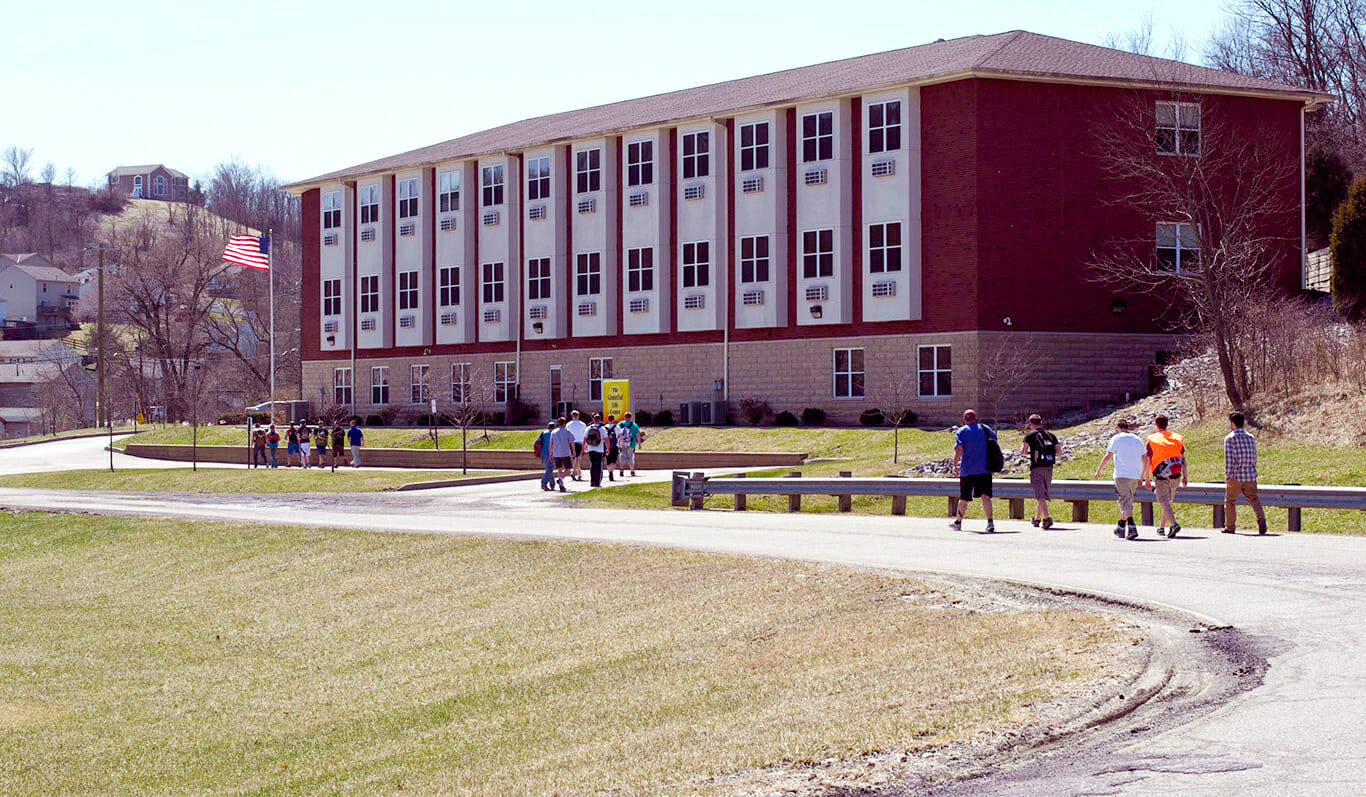
Criminal Rehabilitation and Justice in Kentucky
The following sections summarize criminal justice, prison population, crime rates, recidivism, criminal reform, and alternatives to incarceration in Kentucky.
Kentucky Prison Population Data
Prison population stats provide the most direct insight into a state’s criminal justice system, so when assessing Kentucky’s prisons, the first questions to ask are:
- How many prisoners are in Kentucky?
- What are the biggest prisons in Kentucky?
According to the Bureau of Justice Statistics, Kentucky has the eighth-highest incarceration rate in the nation, ahead of Alabama but behind Georgia. That makes Kentucky’s incarceration rate higher than the U.S. incarceration rate.1
According to data from the National Institute of Corrections, Kentucky has 84 jails in 120 counties.2 The jail population in 2019 was 27,220. Kentucky also manages 12 state prisons, which house 23,082 prisoners. Kentucky operates its prisons and jail facilities with a staff of 4,400 employees and a budget of $620,458,700. According to the Urban Institute, Kentucky’s Department of Corrections is the 6th costliest item in the state’s annual budget.3
The incarceration rate in Kentucky is 516 for every 100,000 people living in the state, significantly higher than the national rate. Conversely, the violent crime rate in Kentucky is only 217 per 100,000, meaning more than 60% of individuals locked up in Kentucky are serving time for nonviolent crimes. Kentucky also operates a community corrections program that manages 49,757 individuals under probation and 14,050 individuals under parole.

As for the timeline of incarceration in Kentucky, the jail population in the state has leveled off, remaining constant for almost 20 years. Conversely, the state’s prison population, where inmates serve longer sentences, has increased significantly since the turn of the century. That means more offenders are being sentenced to long prison sentences instead of shorter sentences or incarceration alternatives.
The Kentucky State Reformatory, located in Lagrange, houses over 2,000 inmates, making it one of the largest prisons in the state by both facility size and prisoner population.4 Kentucky also hosts five federal prisons and has about 4% of its inmates in private prisons.5
Crime Rates in Kentucky
Federal agencies and state institutions report crime rates in Kentucky. According to the Bureau of Justice Assistance, Kentucky records 9,000 to 10,000 violent crimes annually, including 160 to 200 murders/manslaughters, 2,700 rapes, 3,200 robberies, and 4,200 aggravated assaults. That institution reports 104,000 to 112,000 property crimes annually, including 26,000 burglaries, 75,000 thefts, and 6,000 motor vehicle thefts. Kentucky law enforcement officers perform about 178,000 arrests per year.6
According to a state report published in 2021, Kentucky recorded 46,788 assaults, 13,409 burglaries, 57,580 drug offenses, 626 homicides, 56,917 thefts, 2,534 robberies, and 38 crimes related to human trafficking.7
Recidivism Rates in Kentucky
One of the most critical metrics to analyze criminal justice in Kentucky is to focus on statistical data on recidivism. According to the federal institution cited in the previous section, Kentucky has a recidivism rate of 29.5%, meaning the criminal justice system is not working for about one-third of those who go through it.
“When resources and assistance are made available to those exiting the criminal justice system, recidivism is reduced, which produces a positive outcome for the community at large, and that’s something we can all agree is a good thing.”
However, this figure is a historic low for Kentucky. The state’s reporting data estimates the recidivism rate is even lower than the federal data, putting the recidivism rate at 29.17%. Quoting Kentucky Governor Andy Beshear, “This national recognition is a nationwide effort to raise awareness of the wider consequences of a criminal conviction, and to unlock opportunities for people who have completed their debts to society. When resources and assistance are made available to those exiting the criminal justice system, recidivism is reduced, which produces a positive outcome for the community at large, and that’s something we can all agree is a good thing.” With that in mind, Kentucky should continue finding ways to reduce recidivism.8
Criminal Reform in Kentucky
What does criminal rehabilitation look like in Kentucky? The Kentucky criminal justice system utilizes several reform techniques and evidence-based criminal rehabilitation modalities to help offenders reform. Some of these include:
- Behavioral counseling in prison
- Group therapy sessions in prison
- Workforce training and employment
- Vocational courses and post-incarceration preparation
- Drug and alcohol rehabilitation services for incarcerated individuals
Kentucky also utilizes Pretrial Substance Abuse Programs (PSAPs). These programs are for people who have been arrested and charged with crimes but are still considered innocent until proven guilty. Such programs allow pretrial defendants to enter a six-month drug rehab program within a jail. Completing the program can help defendants avoid a felony.9
Alternatives to Incarceration in Kentucky
Often, a prison sentence is not the correct approach to reforming an offender’s behavior. Particularly in instances of nonviolent crime or illicit substance possession, alternatives to prison in Kentucky would be a far better approach. Some of the current alternatives to incarceration in Kentucky are:
- Drug court
- Mental health court
- Family treatment programs
- Domestic violence programs
- Services for veterans who offend
- Juvenile delinquency court programs
- Female offender programs for juveniles and adults
- Programs for adults apprehended while driving under the influence
Kentucky also manages several recovery and reentry centers that help offenders receive the care they need to re-enter society.10 Such programs include:11

Grateful Life Center, Kentucky
- Grateful Life Center
- Genesis Recovery Center
- Dismas Charities – Diersen
- The Burns M. Brady Center
- Center Point Recovery Center
- Cumberland Hope Community
- The Healing Place of Campbellsville
- Bluegrass Career Development Center
- Brighton Recovery Center for Women
- Hope Center, Inc. – George Privett for Men
- Hope Center, Inc. – Ball-Quantrell Jones for Women
In the future, educational programs inside prisons in Kentucky should be implemented and expanded to ensure offenders can improve their comprehension and understanding of crime, morality, life skills, problem-solving, and coping strategies. Further, the state should expand rehabilitation programs inside prisons in Kentucky so offenders can get to the bottom of why they committed the crime in the first place.
Sources:
- BJS. “Prisoners in 2020 – Statistical Tables.” Bureau of Justice Statistics, 2021. bjs.ojp.gov
- NIC. “Kentucky 2019.” National Institute of Corrections, 2022. nicic.gov
- Urban. “Project Kentucky.” Urban Institute, 2022. urban.org
- Oldham KY. “Kentucky State Reformatory.” Oldham County History Center, 2022. oldhamkyhistory.com
- SentencingProject. “Private Prisons in the United States.” The Sentencing Project, 2020. sentencingproject.org
- BJA. “Kentucky.” Bureau of Justice Assistance, 2014. bjafactsheets.iir.com
- KSP. “Crime in Kentucky.” Kentucky State Police, 2021. kentuckystatepolice.org
- Kentucky. “Gov. Beshear, Department of Corrections Celebrate Second Chance Month.” Kentucky. kentucky.gov
- KDC. “Kentucky Corrections Policies and Procedures.” Kentucky Department of Corrections, 2021. corrections.ky.gov
- KDC. “Reentry Service Centers.” Kentucky Department of Corrections, 2022. corrections.ky.gov
- KDC. “Recovery Kentucky.” Kentucky Department of Corrections, 2022. corrections.ky.gov
Related Articles
Criminal Justice Reform Extends Rights to Felons Who Have Served Their Sentences
For decades, voter enfranchisement or disenfranchisement for incarcerated and formerly incarcerated individuals has been debated. An estimated 4.6 million Americans are barred from voting due...
Read more >>
Kentucky Is the Latest State to Adopt Rehabilitation Over Incarceration for Nonviolent Drug Offenders
Several states across the country have been revisiting certain laws enacted during the War on Drugs era, laws that resulted in harsh sentences for people...
Read more >>
What Is the Scope of Private Prisons in the U.S.?
In 2001, the Federal Bureau of Justice Assistance authored a report analyzing then-emergent issues regarding private prisons in the United States. According to the authors...
Read more >>
Study Skills for a New Life
Learning Skills for Life Success “Well, this lesson of Criminon helped me to learn some new techniques I could use when studying. The Barriers to...
Read more >>





